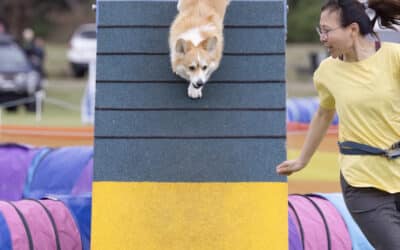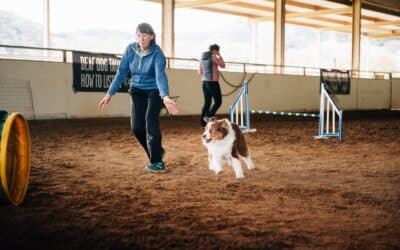Have you found your heart pounding as you enter the agility competition ring? Nervous energy fluttering in your stomach, your palms slightly sweaty? If you’ve stepped into an agility ring, chances are that you’ve experience ring nerves. Guess what, it’s not just your dog feeling the pressure in the agility competition environment. Ring stress affects handlers too!
Understanding the dynamics of nerves in agility
Ring nerves stem from various sources—be it witnessing others’ performances, setting unrealistic goals, or fixating on outcome-based achievements. While some nerves can be a catalyst for preparation and heightened performance, disruptive nerves hinder your best efforts. They disrupt timing, attention, and decision-making, often triggered by self-doubt, fatigue, or the relentless pursuit of perfection.
To perform your best in the agility ring, you need to be both physically alert and mentally primed for the challenge. Many competitors vouch for a suitable level of nervousness—a state where sharpness meets relaxation, fostering confidence and readiness. This state, in sports psychology, is termed the “performance-appropriate state of alertness.” Learn more in our Mental Training article series on OneMind Dogs learning platform.
Navigating ring nerves for agility handlers
Self-awareness is the key. Acknowledge how nerves impact your runs. Identify triggers affecting your confidence and concentration. But fear not, there’s a way out!
🗣️ Positive Self-Talk: Speak to yourself as you would to your best friend. Encourage and support your abilities.
🏋️♂️ Trust Your Training: You’ve put in the work; trust it. You know your dog best, and you’ve prepared together.
🐕🦺 Train Like You Trial: Mimic your trial conditions in training. Create an environment that replicates the agility competition ring.
🎯 Control the Controllables: Focus on your plan, your actions, and your performance. Forget what’s beyond your control—the judge’s decisions or others’ results.
👥 Find Your Tribe: Surround yourself with positivity. Be the best teammate for your dog and connect with supportive individuals. It’s easier to forget your nerves with your agility buddies surrounding you!
Harnessing your nervous system
Did you know your body’s autonomous nervous system influences your agility performance? This internal regulator manages your alertness levels, directly affecting your nerves. Learning to influence this involuntary system is vital for competing handlers.
Some methods directly affect your heart rate and breathing. Others—relaxation techniques, mental imagery, or specific emotions—indirectly impact your state of alertness. It’s about recognizing your optimal state, practicing preparation, and turning these routines into your competition ritual.
Embracing appropriate nerves in agility
Believe it or not, a healthy level of tension is an excellent motivator. For example, a bit of stress can fuel meticulous preparation and detailed planning. But finding the balance is crucial—excessive tension impairs performance, distorts decision-making, and can affect your overall well-being.
If you’d like to learn more, click here to sign up for a free webinar by OneMind Dogs instructor Lynn Madden. Let’s navigate these ring nerves together and turn them into tools for agility success!
Conquering anxiety in agility
Controlling performance anxiety requires dedication and effort. It’s a journey that demands time, perseverance, and a willingness to confront your inner challenges. But is it worth it? Let’s consider the impact disruptive tension has on your performance, training, and overall enjoyment of the sport.
If tension significantly impairs your agility performances, impeding your training progress and dampening the joy you feel from competing, then it’s worth making a commitment to tackle these challenges head-on.
Exploring control methods for nerves in agility
There is no one-size-fits-all approach to managing performance anxiety. Experiment with various control methods tailored to your symptoms and triggers. Techniques such as relaxation exercises, arousal manipulation, and thought pattern redirection can be transformative.
State of arousal
Learning to manipulate your alertness level through movement, music, or mental imagery is key. Practice these methods to gain better control over your autonomous nervous system.
Thoughts control
Identify negative thought patterns and challenge them with rational, supportive counterarguments. Rethink self-criticism, set achievable goals, and avoid result-centric expectations.
Reinforcing self-confidence
Celebrate successes, no matter how small, and use positive mental imagery of successful performances to combat tension during training and before competitions.
Embracing a relaxed attitude in the agility ring
Remember, agility is FUN! Reevaluate the significance of competition outcomes on your self-worth. Let go of the need for perfection and focus on enjoying the journey.
Handling team and major Competitions
In team competitions, concentrate on your performance and avoid pressure from your own or others’ expectations. Maintain a relaxed attitude even in major events, the connection with your dog is the most important factor to focus on.
OneMind Dogs Agility Premium: Your mental training hub
Self-knowledge and control over performance anxiety are integral to agility success. To delve deeper into mental training content, explore OneMind Dogs Agility Premium. It provides detailed insights and tools to further enhance your mental fortitude and agility prowess.
Invest in yourself, understand your triggers, and equip yourself with effective strategies to conquer your ring nerves. Unleash your true potential in the competition ring!



